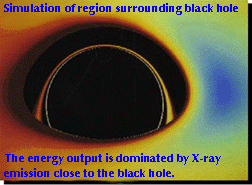Einstein Passes Another Test
Einstein Passes Another Test
| 07 November 1997 |

|
Astronomers using NASA's Rossi X-ray Timing Explorer (RXTE) spacecraft reported on November 6 that they have observed a black hole that is literally dragging space and time around itself as it rotates. This bizarre effect, called "frame dragging," is the first evidence to support a prediction made in 1918 using Einstein's Theory of Theory of Relativity.
The phenomenon is distorting the orbit of hot, X-ray emitting gas near the black hole, causing the X-rays to peak at periods that match the frame dragging predictions of general relativity. The research team, led by Dr. Wei Cui of the Massachusetts Institute of Technology, announced its results in a press conference during the American Astronomical Society's High Energy Astrophysics Division (HEAD) meeting in Estes Park, CO. Collaborators in the research include Dr. Wan Chen of NASA's Goddard Space Flight Center, Greenbelt, MD, and Dr. Shuang N. Zhang of NASA's Marshall Space Flight Center, Huntsville, AL.
"If our interpretation is correct, it could demonstrate the presence of frame dragging near spinning black holes," said Cui. "This observation is unique because Einstein's theory has never been tested in this way before."
Black holes are very massive objects with gravitational fields so intense that near them, nothing, not even light, can escape their pull. This effect shrouds the hole in darkness, and its presence can only be inferred from its effects on nearby matter. Many of the known or suspected black holes are orbiting a close "companion" star. The black hole's gravity pulls matter from the companion star, which forms a disk around the black hole as it is drawn inward by the black hole's gravity, much like soap suds swirling around a bathtub drain. Gas in this disk gets compressed and heated and emits radiation of various kinds, especially X-rays.
The research team used these X-ray emissions to determine if frame dragging was present. The team found that the X-ray emissions were varying in intensity. By analyzing this variation, they found a pattern, or repetition, that was best explained by a perturbation in the matter's orbit. This perturbation, called a precession, occurs when the orbit itself shifts around the black hole. This is evidence for frame dragging because as the matter orbits the black hole, the space-time that is being dragged around the black hole drags the matter along with it. This shifts the matter's orbit with each revolution.
Einstein's Theory of General Relativity has been highly successful at explaining how matter and light behave in strong gravitational fields, and has been successfully tested using a wide variety of astrophysical observations. The frame dragging effect was first predicted using general relativity by Austrian physicists Joseph Lense and Hans Thirring in 1918. Known as the Lense-Thirring effect, it has not been definitively observed thus far, so scientists will scrutinize the new reports very carefully.
The possible detection of frame dragging around another type of very dense, rapidly spinning object called a neutron star was accomplished recently by Italian astronomers, Drs. Luigi Stella of the Astronomical Observatory of Rome, and Mario Vietri of the Third University of Rome. Their observations were also made using the RXTE, which is available for use by astronomers throughout the world, and led Dr. Cui's team to seek the effect near black holes.
"This is exciting work that needs further confirmation, as for any seemingly major advance in science," said Dr. Alan Bunner, Director of the Structure and Evolution of the Universe Program at NASA Headquarters, Washington, DC.
The RXTE spacecraft is a 6,700 pound observatory placed into orbit by NASA in December 1995. Its mission is to make astronomical observations from high-energy light in the X-ray range, which is emitted by powerful events in the Universe. These events are often associated with massive, compact objects such as black holes and neutron stars.

